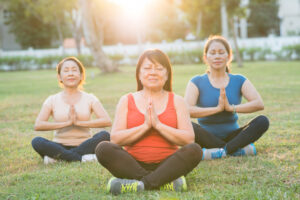
In today’s multiethnic society, the word “Yoga” is most often connected with a group of popular forms of exercise, such as weight lifting, Pilates, or stretching. The reality, however, is that Yoga is an ancient, very intricate practice that has been around for thousands of years and has its origins in Indian philosophy. People practiced yoga to inculcate a sense of self-awareness in the body and mind.
“Yoga” is a catch-all phrase that can refer to a wide range of disciplines and systems. When yoga is mentioned, it is usually about Hatha. Hatha is a gentle form of yoga ideal for beginners since it stresses holding poses for a while. The three main parts are:
Pranayama: The initial section of most hatha yoga programs focuses on pranayama, or breathing exercises. The teacher will keep bringing your attention back to the breath as you progress through the poses and may suggest new breathing techniques.
Pose: Yoga poses, also known as postures or asanas, are a collection of poses and holds that can do wonders for your strength, mobility, and balance. There is a wide spectrum of difficulty in yoga poses, from lying on the floor to extreme inversions. Any time a class finds a position too difficult, the teacher might provide an alternative.
Meditation: Class time often concludes with a brief moment of meditation. The teacher may meditate with the class during this time of introspection.
The practice of yoga is growing in popularity among the elderly because of its many advantages without the usual dangers of exercise. The individuals you care for can benefit from your exploration of yoga practices and incorporating even the most fundamental poses into your daily routine. Here is how Yoga can benefit your older ones:
Maintaining a Healthier Balance
Fractures and breaks are more common among the elderly because of the increased likelihood of falling. Iyengar Yoga places a premium on correct alignment and form; therefore, its practices tend to be deliberate and exact. Individuals can achieve proper posture and balance using bolsters, straps, blocks, and inclination boards.
Strengthen Core
When people reach their 40s, muscle mass loss can begin, and after age 50, it often accelerates. Because of this slow but steady decline, seniors may feel they are losing their strength and autonomy if nothing is done to help them. Although age-related muscle loss is unavoidable, there are steps people can take to delay or even halt this natural process. The adage holds: “you have to use it or lose it.”
Extreme Stretching
Many older adults suffer from chronic back pain that is bothersome and potentially debilitating. When you commit to regular Yoga practice, you’ll be able to stretch and move your body in ways you never thought possible, including twisting and bending your spine in all directions. Consequently, even a brief, once-daily yoga practice—even just 10 minutes—may help strengthen a senior’s flexibility, leading to more mobility and comfort.
Reducing Stress
Yoga combines meditation and breathing techniques to help you concentrate on the here and now and find calm inside yourself. The stress hormone cortisol is lowered, and anxious and depressive symptoms are alleviated, as shown by scientific studies, and Yoga has been shown to do the same. Improved cardiovascular health is only one of the many benefits of reduced systemic inflammation. High blood pressure, obesity, and stress are all risk factors for cardiovascular disease, yet yoga can help decrease many of these symptoms.
Get in touch with us now to find out more about the compassionate and skilled personal caregivers, RNs, Yoga Specialists, and home health aides who work with your family. It is our pleasure to help you and your loved ones. Don’t hesitate to contact us at 888 447 0407 if you have any inquiries.
